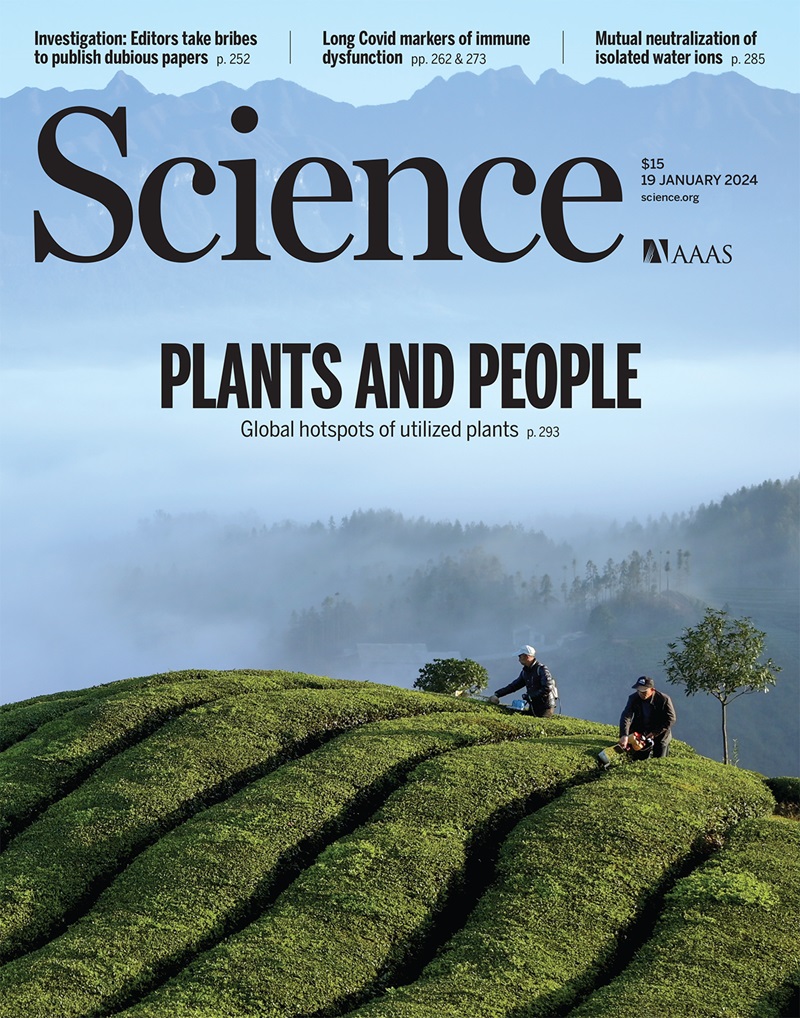流感核糖核蛋白复合物组装和过程RNA合成的分子基础
IF 44.7
1区 综合性期刊
Q1 MULTIDISCIPLINARY SCIENCES
Science
Pub Date : 2025-05-15
引用次数: 0
摘要
流感病毒在保守核糖核蛋白(RNP)复合体的背景下复制和转录其基因组。通过低温电子显微镜单粒子分析和低温电子断层扫描,我们将流感RNP定义为一个右旋的反平行双螺旋结构,病毒RNA被封装在小槽中。单个核蛋白亚基通过一个灵活的尾环连接起来,该尾环插入邻近的保守口袋中。我们可视化了不同功能状态下RNP中的病毒聚合酶,揭示了它如何通过链滑动来访问RNA模板,同时保持RNP的双螺旋结构。针对尾环结合界面,我们确定了作为潜在抗流感抑制剂的先导化合物。这些发现阐明了支持流感病毒复制的分子决定因素,并突出了抗病毒药物开发的有希望的靶标。本文章由计算机程序翻译,如有差异,请以英文原文为准。
Molecular basis of influenza ribonucleoprotein complex assembly and processive RNA synthesis
Influenza viruses replicate and transcribe their genome in the context of a conserved ribonucleoprotein (RNP) complex. By integrating cryo–electron microscopy single-particle analysis and cryo–electron tomography, we define the influenza RNP as a right-handed, antiparallel double helix with the viral RNA encapsidated in the minor groove. Individual nucleoprotein subunits are connected by a flexible tail loop that inserts into a conserved pocket in its neighbor. We visualize the viral polymerase in RNP at different functional states, revealing how it accesses the RNA template while maintaining the double-helical architecture of RNP by strand sliding. Targeting the tail loop binding interface, we identify lead compounds as potential anti-influenza inhibitors. These findings elucidate the molecular determinants underpinning influenza virus replication and highlight a promising target for antiviral development.
求助全文
通过发布文献求助,成功后即可免费获取论文全文。
去求助
来源期刊

Science
综合性期刊-综合性期刊
CiteScore
61.10
自引率
0.90%
发文量
0
审稿时长
2.1 months
期刊介绍:
Science is a leading outlet for scientific news, commentary, and cutting-edge research. Through its print and online incarnations, Science reaches an estimated worldwide readership of more than one million. Science’s authorship is global too, and its articles consistently rank among the world's most cited research.
Science serves as a forum for discussion of important issues related to the advancement of science by publishing material on which a consensus has been reached as well as including the presentation of minority or conflicting points of view. Accordingly, all articles published in Science—including editorials, news and comment, and book reviews—are signed and reflect the individual views of the authors and not official points of view adopted by AAAS or the institutions with which the authors are affiliated.
Science seeks to publish those papers that are most influential in their fields or across fields and that will significantly advance scientific understanding. Selected papers should present novel and broadly important data, syntheses, or concepts. They should merit recognition by the wider scientific community and general public provided by publication in Science, beyond that provided by specialty journals. Science welcomes submissions from all fields of science and from any source. The editors are committed to the prompt evaluation and publication of submitted papers while upholding high standards that support reproducibility of published research. Science is published weekly; selected papers are published online ahead of print.
 求助内容:
求助内容: 应助结果提醒方式:
应助结果提醒方式:


